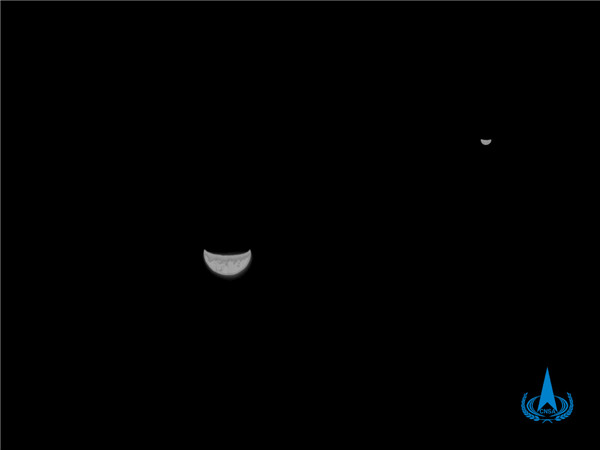Home> News
Tianwen 1 sends photo of Earth, moon from 1.2 million km away
Updated: 2020-07-30 (chinadaily.com.cn)

Tianwen 1 sends a picture featuring the Earth and moon. [Photo/China National Space Administration]
China's Tianwen 1 Mars probe sent back a picture of Earth and the moon to ground control on Monday, the China National Space Administration said on Tuesday.
The black-and-white picture was taken by the optical navigation sensor on the spacecraft when it was about 1.2 million kilometers away from Earth at the time it was shot, the administration said in a statement, noting the operation was controlled by the Beijing Aerospace Control Center and China Academy of Space Technology.
As of Tuesday evening, the probe was in good condition and had departed the Earth's gravitational pull to enter an interplanetary transfer trajectory, the statement said. It added that the spacecraft is more than 1.5 million km away from Earth.
China launched Tianwen 1, the country's first independent Mars mission, on July 23 at the Wenchang Space Launch Center in South China's Hainan province, opening the nation's planetary exploration program.
If everything goes according to schedule, the 5-metric ton Tianwen 1, which consists of two major parts – the orbiter and the landing capsule - will travel more than 400 million kilometers in about seven months before getting captured by the Martian gravitational field.
After the probe enters Mars orbit, it will revolve around the planet for two and a half months to investigate the landing capsule's preset landing site before descending to a certain altitude to release the landing capsule.
The capsule will then fall through Mars' atmosphere and take a succession of sophisticated steps to decelerate and soft-land on Martian soil. After the landing, it will release the rover to roam on the Martian surface for scientific survey.
The landing is scheduled to take place next May in the southern part of Mars' Utopia Planitia, a large plain within Utopia, the largest recognized impact basin on Mars and in the solar system, according to the space administration.
